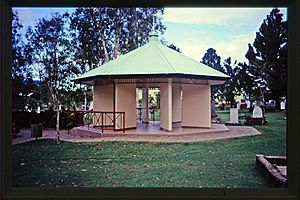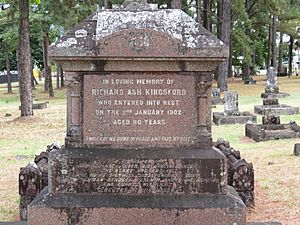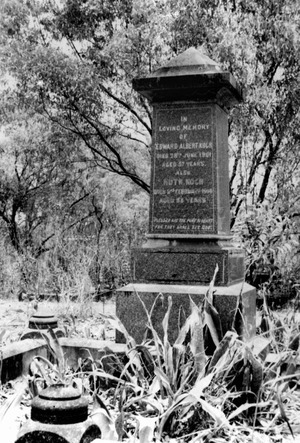McLeod Street Pioneer Cemetery facts for kids
Quick facts for kids McLeod Street Pioneer Cemetery |
|
|---|---|

McLeod Street Pioneer Cemetery, 1992
|
|
| Location | 127-145 McLeod Street, Cairns North, Cairns Region, Queensland, Australia |
| Design period | 1870s - 1890s (late 19th century) |
| Built | 1877 - 1954 |
| Official name: McLeod Street Pioneer Cemetery, Cairns General Cemetery | |
| Type | state heritage (built, landscape) |
| Designated | 21 October 1992 |
| Reference no. | 600383 |
| Significant period | 1877-(social) 1877-1954(historical, fabric) |
| Significant components | cemetery, trees/plantings, fence/wall - perimeter, memorial/monument, burial/grave, headstone, rotunda |
| Lua error in Module:Location_map at line 420: attempt to index field 'wikibase' (a nil value). | |
The McLeod Street Pioneer Cemetery is a very old and important cemetery located in Cairns North, Queensland, Australia. It was used for burials from 1877 until 1954. This special place is also known as the Cairns General Cemetery or Cairns Pioneer Cemetery. It was added to the Queensland Heritage Register on 21 October 1992, meaning it's protected because of its historical value.
Contents
Discovering the Cemetery's Past
How Cairns Began
The city of Cairns officially started in October 1876. It was created as a port to serve the new goldfields found nearby. When the town was first planned, no specific area was set aside for a public cemetery. So, the earliest burials happened along the Esplanade, which was north of the town center.
Choosing the Cemetery Site
On 15 September 1877, about a year after Cairns was founded, a 5-acre piece of land was officially made a permanent cemetery. This land was located between McLeod, Gatton, and Grove Streets. The very next month, another 5 acres next to it was also made a cemetery reserve.
This 10-acre site was chosen because people thought it was dry ground. It was also far enough from the main part of town and easy to reach from the hospital. However, they later found out the site was often wet and flooded. This meant graves could not be dug very deep, only about 3 feet (0.91 m).
Early Challenges and Management
People were chosen to manage the cemetery in December 1877. But for several years, the McLeod Street cemetery wasn't properly looked after. There was no one in charge, and no records were kept of who was buried there. There wasn't even a proper road to the site, and the land was not cleared.
New managers were appointed in September 1883. In 1884, they asked the Queensland government for money to set up the Cairns General Cemetery. They also wanted rules approved for how to run it. They received a loan of £200. Rules for the cemetery were made official on 5 July 1884.
In August 1884, the managers asked for bids to build a fence around the cemetery. By February 1885, a caretaker was hired. They also started clearing the land and fencing the burial ground.
Dividing the Cemetery Sections
At first, only half of the first 5-acre section was fenced for burials. The cemetery was divided into different areas for various Christian groups. There was also a section for non-Christians. This area included people from China, Malaysia, Java, and Aboriginal people. It's thought that Jewish people might have had their own section too. Chinese people were very important to Cairns' growth. They used to celebrate a special "feast of the dead" three times a year at the cemetery.
Improvements Over Time
By the late 1800s, the cemetery had become messy. In 1900, the managers asked to increase burial fees to pay for improvements. A new caretaker, William Parsons, was hired. He worked hard to make things better.
- The main path was paved and lined with colorful plants.
- Flowering bushes and trees were planted along the fence facing McLeod Street.
- Weeds were removed from the graves.
- New grass was brought in and planted.
In 1914, a new fence and two gates were put up, but these are no longer there today.
Closing the Cemetery
A new cemetery opened in Martyn Street on 22 December 1916. After this, people could only be buried in McLeod Street if they were joining family members already there. The very last burial happened in 1949. The cemetery was officially closed on 11 May 1954.
Records show that between 1887 and 1949, about 2500 people were buried at McLeod Street.
Why the Site Stayed in Use
The McLeod Street site wasn't ideal because it flooded easily. But it remained Cairns' main cemetery for about 30 years. This was because it was hard to find a good new location. As early as 1885, the managers looked for other sites. In 1886, the government set aside a 40-acre site almost four miles from town.
However, this new site was too difficult to reach. It was cancelled in 1890. Another 40-acre cemetery site was then chosen near Stratford. Even though it was near the railway, it was never used as a cemetery.
In 1905, the Cairns Town Council took over managing the cemeteries. They thought this meant they were in charge of McLeod Street, which became official in 1923.
Restoring the Pioneer Cemetery
The Cairns City Council tried several times to turn the McLeod Street cemetery into a park, but they couldn't get permission. Finally, in 1988, the Council decided to restore the old cemetery.
With help from local groups and volunteers, they:
- Restored about 290 graves that were still visible.
- Found over 200 grave sites that had been "lost."
- Removed large trees that were damaging graves.
- Rebuilt the fence along the railway line.
- Lit up the main pathway.
- Built a small information center.
The site was renamed the McLeod Street Pioneer Cemetery. Today, it is a popular place for tourists to visit in Cairns.
Important People Buried Here
Many important people from early Cairns history are buried at McLeod Street. These include:
- Richard Ash Kingsford: The first mayor of Cairns.
- Dr Edward Albert Koch: A respected doctor who helped many people in Cairns.
- Workers who died while building the railway from Cairns to Herberton.
- A fisherman who was in Trinity Bay even before Cairns was founded.
The headstones that remain show people from all parts of early Cairns society. This includes doctors, business owners, religious leaders, and politicians. The cemetery also shows how diverse early Cairns was. People from many countries are buried there, including England, Ireland, Scotland, Japan, Java, China, India, Italy, Bulgaria, and Sweden.
What the Cemetery Looks Like Today
The Pioneer Cemetery is on flat land at the corner of McLeod and Grove Streets. It has the Cairns railway on one side and industrial buildings on the other.
The cemetery is kept very neat and tidy. Many trees that were harming the graves have been removed. A lot of new plants have been added. A rotunda (a round building with a roof) was built in the middle. It has information about the cemetery.
Paths lined with colorful native plants lead to McLeod Street and Grove Street. These paths are like the ones that were there in 1901. There are some large pine trees, but they will be removed eventually. This is because the acid from their needles can damage the marble on the graves.
The cemetery has different sections for various religious groups. These include Protestant, Roman Catholic, mixed Christian groups, and non-Christian areas.
Graves and Memorials
Even though there are over 2500 graves, many are still hidden. Special tools like metal detectors have been used to find grave markers underground. Each found grave is marked with a small concrete block. These blocks have brass plaques with the person's name, birth year and place, death year, last home, and job if known.
About 200 graves have been clearly identified. Another 100 have been found but don't have enough information to know who is buried there. Since only about 600-700 graves can be accurately found, the names of everyone buried there will be put in the rotunda.
Many graves have concrete edges and marble headstones. Some still have old iron railings around them, but some of these are broken or missing. There are also a few very large, impressive graves with carved granite and marble headstones.
A timber fence has been built along the railway side. Pine log barriers are along the two street sides.
Notable Interments
- Richard Ash Kingsford, who was a mayor of both Brisbane and Cairns, and a member of the Queensland Legislative Assembly.
- Edward Albert Koch, a well-known doctor in Cairns.
Why This Place is Special
The McLeod Street Pioneer Cemetery is listed on the Queensland Heritage Register because it meets important criteria:
Showing Queensland's History
This cemetery is a unique historical record. It shows the diverse social, economic, and political life of early Cairns. It also helps us understand the major events that shaped Cairns and Far North Queensland in the late 1800s and early 1900s.
Showing Cemetery Features
The way the graves are arranged, with different religious sections and types of memorials, shows what people thought about burials and remembering the dead in the late 19th and early 20th centuries.
Aesthetic Value
The cemetery is also beautiful and adds to the look and feel of the Cairns townscape.
Images for kids




